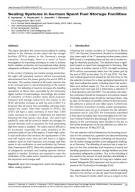Details
- Identification
- ISSN: 1977-5296, DOI: 10.3011/ESARDA.IJNSNP.2017.16
- Publication date
- 1 December 2017
- Author
- Joint Research Centre
Description
Volume: 55, December 2017, pages 39-43,
Authors: K. Aymanns1, A. Rezniczek2, A. Jussofie3, I. Niemeyer1
1Forschungszentrum Jülich GmbH, 2UBA Unternehmensberatung GmbH, 3BGZ Gesellschaft für Zwischenlagerung mbH
Abstract:
This paper describes the current issues related to sealing devices in the German on-site spent fuel dry storage facilities (SFSFs) related to the Germany’s energy transition. Accordingly, there is a need of future investigations for improving techniques in order to achieve better radiation protection and occupational safety during safeguards verification of spent fuel casks stored in SFSFs.
In the context of phasing out nuclear energy production, the eight still operating reactors will be successively disconnected from the power grid by the end of 2022 at the latest. The nuclear material of all power reactors has to be removed prior to decommissioning of the reactor building. The defueling of reactors increases the handling operations at these sites especially by the temporary higher number of cask loadings. Accordingly, the number of transfers of these loaded casks (dual purpose: transport and storage casks) from the reactor to the SFSF will further increase as well. By end of 2027, it is foreseen that all spent fuel assemblies will have been loaded into casks. After their transfer to SFSFs, the SFSFs will have a static inventory of more than 1,000 casks, because no receipts or shipments are expected following the final reactor shut down. The spent fuel packed in casks will be stored in interim dry storages for several decades until a repository for heat generating high level waste is available. The casks may be difficult to be accessed; especially the seals attached at the protection plate on top of the approx. 6 meter high casks. A seal verification that involves the replacement of the seal will require more time and will lead to a higher radiation dose for both inspector and storage staff than easier in-situ verification or seal verification by Remote Data Transmission (RDT). Given this situation optimization of safeguards concepts and sealing systems devices applied is needed. Solutions are required to ease the verification of the casks and to minimize the exposure of the inspectors and storage staff.
Keywords: spent fuel management, spent fuel storage facilities, sealing systems
Reference guideline:
Aymanns, K., Rezniczek, A., Jussofie, A., & Niemeyer, I. (2017). Sealing Systems in German Spent Fuel Storage Facilities. ESARDA Bulletin - The International
Journal of Nuclear Safeguards and Non-proliferation, 55, 39-43. https://doi.org/10.3011/ ESARDA.IJNSNP.2017.16

